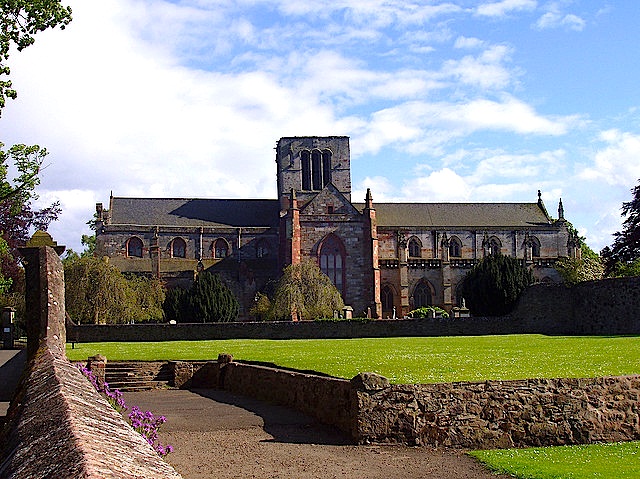|
 “The memory of great men is no less useful
than their presence.”
George, 4th Earl of Winton. “The memory of great men is no less useful
than their presence.”
George, 4th Earl of Winton.
St. Mary's Church, Kirk, formerly known as Grey Friar's Church,
Haddington:
Sir William
Seton, 1st Lord Seton, belonged to the third Order of Saint Francis,
and dying in February, 1409, was buried in the Church of the Franciscan Friars
(The Grey Friars) in Haddington, to whom he left by will six loads of coal
weekly, out of his coal-pit of Tranent, and forty shillings annually, to be
charged on his estate of Barnes.
His widow is
described as a virtuous and energetic woman, who got husbands for four of her
daughters, and built a chantry on the south side of the parish church of Seton,
prepared a tomb for herself there, and made provision for a priest to say mass
perpetually for the repose of her soul.
Haddington had two monastic establishments, one in
the burgh, and one in the village of the Abbey. The former, the large and
venerable structure built in the 12th or 13th century and still in considerable
preservation, was a monastery of Franciscan or 'Grey' friars. Sir John Seton,
2nd Lord Seton appears to have been one of its principal benefactors, and dying
circa 1438, in 1441 was transported and buried within its walls.
Sir John Seton, 1st of Barnes was proprietor of most of the land around Aimsfield,
near to Haddington. He died in 1594 and was buried in the nave of
the old church of Haddington where a grand carved monument
can be seen in the Seton's of the Barnes' burying place.

The
Monument of Provost
Seton of Haddington (of Northrig), his
Father, his Wife, his Mother, &c. In the Kirk.
Memoriae sacrum Gulielmi
Seton, natalibus
hujus urbis Hadinee civis ingenui & honesti;
prosapia autem e vetustissima & nobilissima gente
Setona oriundi; recta quippe serie, ex familia
Setona de Northrig,
jure coniiubii cum illius praedii haerede unica,
cognomine Sinclara, per atavum suinn Gulielmum
Seton, familite
Setonse principis nepotem, olim acquisiti, originem
suam ducentis; praefectura hujus civitatis, per
decennium continuum, fideliter, prudenter & moderate
functi, ejusdemque, ad suprema regni comitia,
delegatione ssepius honorati; officio tabellarii
equestris in hac urbe, per 37 annos, diplomate regio
praepositi; ingenii & monim humanitate, virtute &
industria, omnibus, injuria autem & dolo uemini,
noti; ab avaritia, vindicta, injustitia & in
concives odio prorsus alieni: pie tandem, & qua
christianum decet, animi tranquillitate, anno
eetatis
Busk 57. Vita functi; monumentum hoc,
moeroris & conjugalis sui desiderii signum &
indicium, Agneta Black, ipsius conjugio nunc viduata,
extruendum curavit; locumque simul hunc, cansellis
munitum, in quo reconduntur ossa & cineres Alexandri
Seton, scholse
publiae hujus nrbis quondam moderators ejus patris,
Mariotae Gray matrix, Alexandri, Gulielmi, &
Mariotse, trium ipsius liberornm, dicto connubio,
cum Agneta conjnge sua, procreatorum,
 ut sibi pariter & inariti sui
agnatis cognatisque com fatis cesserint, sepulturam
commodam prsebeat, auctoritate parochiali,
religiosum fecit. Anno 1682. ut sibi pariter & inariti sui
agnatis cognatisque com fatis cesserint, sepulturam
commodam prsebeat, auctoritate parochiali,
religiosum fecit. Anno 1682.
Consecrate to the memory of William
Seton, by birth a citizen of
this town of Hadingtoun, candid and honest; but by his
pedegree descended from the most ancient and most noble
family of Seton, as deriving
his original in a right line from the house of
Seton of
Northrig, of old acquired by
his great grandfathers father, William
Seton, great grandchild to
the chief of the family of Seton,
by right of marriage with the only heiress of that
room, sir-named Sinclar.
He was provest of this city for the
space of ten years together, in all fidelity, prudence, and
moderation, ofttimes town's commissioner to the parliaments,
and postmaster of the town by the king's patent, for the
space of 37 years. For wisdom, courtesie, virtue, and
industry, he was known to all; for injury or deceit, known
to none ; altogether averse from covetousness, revenge,
injustice, or hatred against his fellow-citizens.
At last,
having died piously and peaceably as becomes a Christian, in
the 57 year of his age, Agnes Black his relict caused erect
this monument as a sign and
token of her grief and conjugal affection; and, by publick
order of the kirk-session, set apart this room, hedged in
with iron-grates, wherein are reposed the bones and dust of
Mr. Alexander Seton, sometime
schoolmaster of the publick school of this city his father,
Mareon Gray his mother, Alexander, William, and Mareon
Setons, three of his children procreate by him, with the
said Agnes Black in the said marriage, that it might be a
convenient burial-place for her self and for the kindred and
friends of her husband, when they should depart this life.
|

